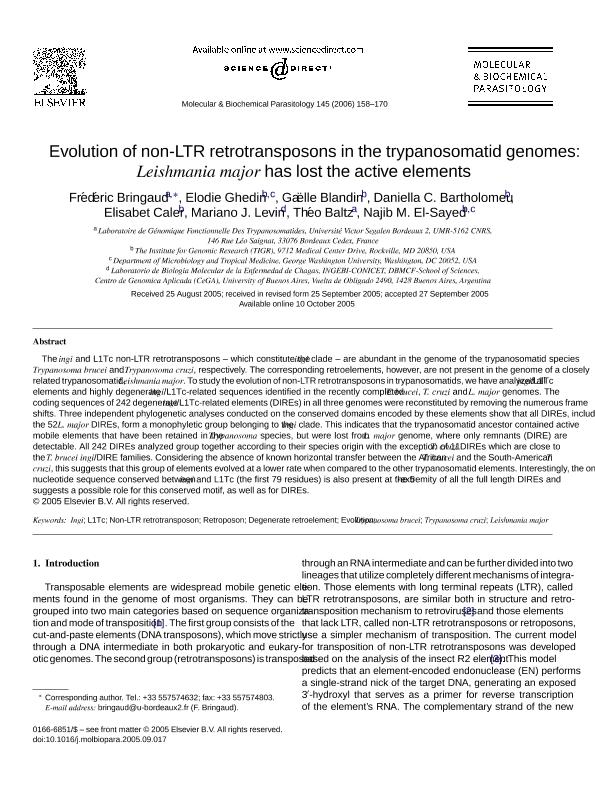Artículo
Evolution of non-LTR retrotransposons in the trypanosomatid genomes: Leishmania major has lost the active elements
Bringaud, Frédéric; Ghedin, Elodie; Blandin, Gaëlle; Bartholomeu, Daniella C.; Caler, Elisabet; Levin, Mariano Jorge ; Baltz, Théo; El Sayed, Najib M.
; Baltz, Théo; El Sayed, Najib M.
 ; Baltz, Théo; El Sayed, Najib M.
; Baltz, Théo; El Sayed, Najib M.
Fecha de publicación:
12/2006
Editorial:
Elsevier Science
Revista:
Molecular and Biochemical Parasitology
ISSN:
0166-6851
Idioma:
Inglés
Tipo de recurso:
Artículo publicado
Clasificación temática:
Resumen
The ingi and L1Tc non-LTR retrotransposons - which constitute the ingi clade - are abundant in the genome of the trypanosomatid species Trypanosoma brucei and Trypanosoma cruzi, respectively. The corresponding retroelements, however, are not present in the genome of a closely related trypanosomatid, Leishmania major. To study the evolution of non-LTR retrotransposons in trypanosomatids, we have analyzed all ingi/L1Tc elements and highly degenerate ingi/L1Tc-related sequences identified in the recently completed T. brucei, T. cruzi and L. major genomes. The coding sequences of 242 degenerate ingi/L1Tc-related elements (DIREs) in all three genomes were reconstituted by removing the numerous frame shifts. Three independent phylogenetic analyses conducted on the conserved domains encoded by these elements show that all DIREs, including the 52 L. major DIREs, form a monophyletic group belonging to the ingi clade. This indicates that the trypanosomatid ancestor contained active mobile elements that have been retained in the Trypanosoma species, but were lost from L. major genome, where only remnants (DIRE) are detectable. All 242 DIREs analyzed group together according to their species origin with the exception of 11 T. cruzi DIREs which are close to the T. brucei ingi/DIRE families. Considering the absence of known horizontal transfer between the African T. brucei and the South-American T. cruzi, this suggests that this group of elements evolved at a lower rate when compared to the other trypanosomatid elements. Interestingly, the only nucleotide sequence conserved between ingi and L1Tc (the first 79 residues) is also present at the 5′-extremity of all the full length DIREs and suggests a possible role for this conserved motif, as well as for DIREs.
Archivos asociados
Licencia
Identificadores
Colecciones
Articulos(INGEBI)
Articulos de INST.DE INVEST.EN ING.GENETICA Y BIOL.MOLECULAR "DR. HECTOR N TORRES"
Articulos de INST.DE INVEST.EN ING.GENETICA Y BIOL.MOLECULAR "DR. HECTOR N TORRES"
Citación
Bringaud, Frédéric; Ghedin, Elodie; Blandin, Gaëlle; Bartholomeu, Daniella C.; Caler, Elisabet; et al.; Evolution of non-LTR retrotransposons in the trypanosomatid genomes: Leishmania major has lost the active elements; Elsevier Science; Molecular and Biochemical Parasitology; 145; 2; 12-2006; 158-170
Compartir
Altmétricas



